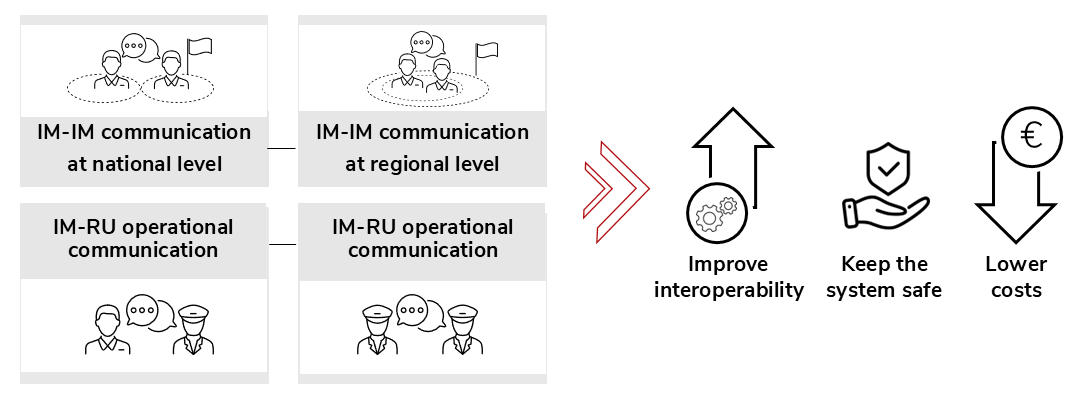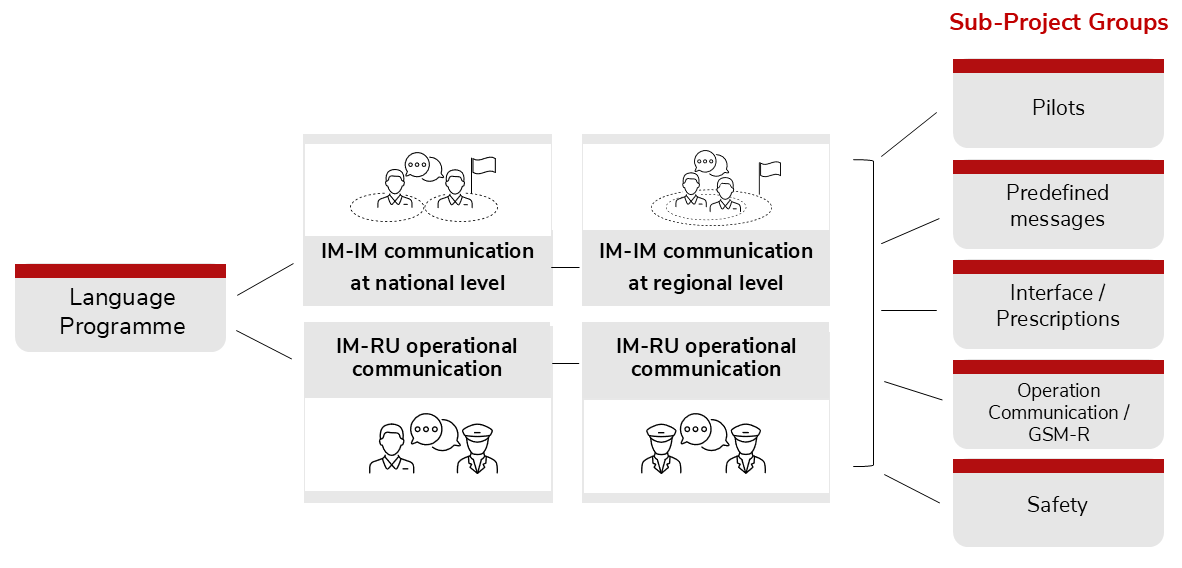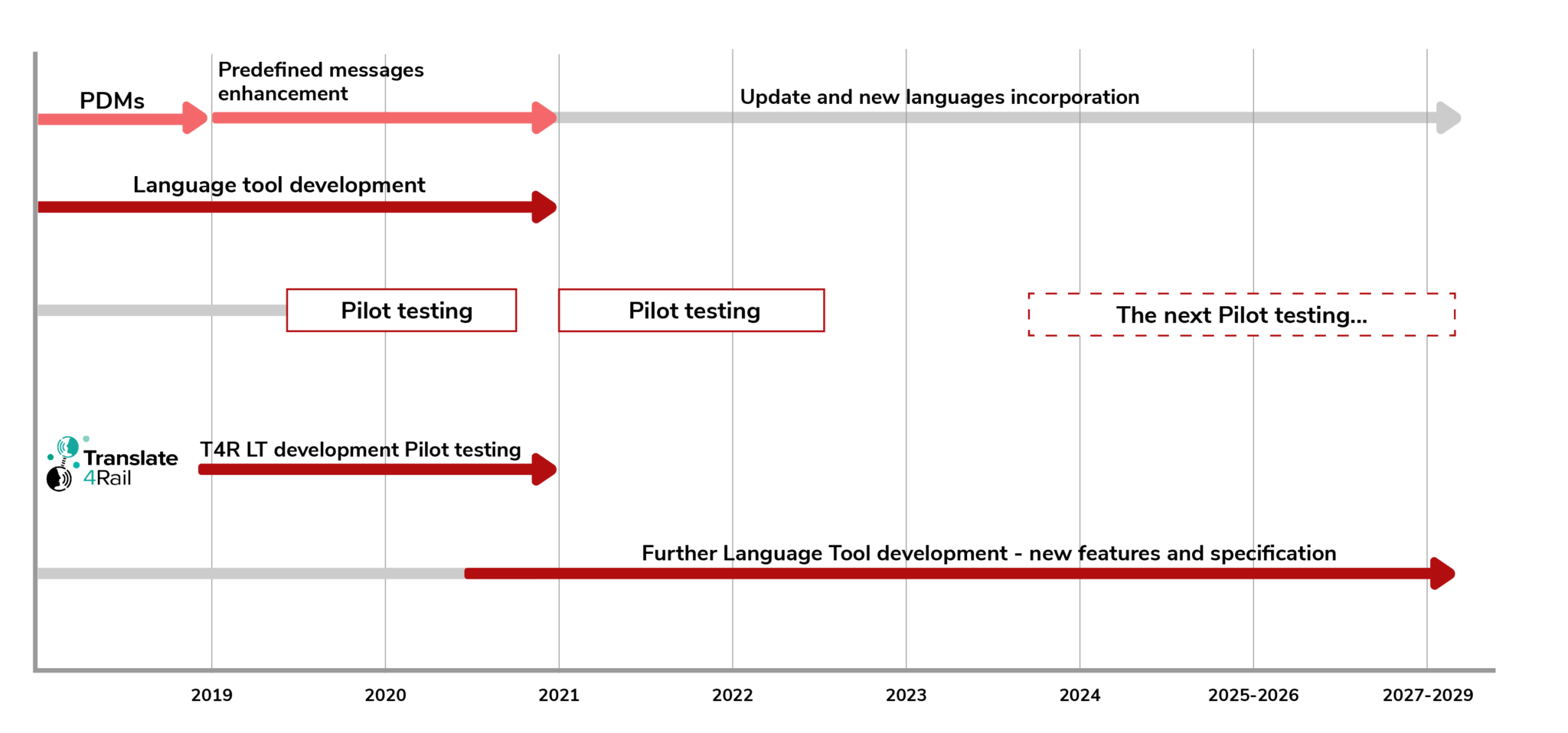Removing Language Barriers
The Language Programme was initiated by RNE in December 2017 as the answer to the need to remove the language barriers in railway operational communication. From the beginning of the programme, the main goal was set up in a solution suitable for all environments in the sector to overcome the language barriers.
Reflecting to that, four main areas of interest were identified to work with:
4 main areas of interest
contribute to an increase
in cross-border traffic
The Language Programme should lead to more efficient international train operation with a focus on communication aspects.
The activities under the sector’s Language Programme are led by RNE in cooperation with railway associations and authorities, such as UIC, ERFA, ERA, CER and EIM. This group represents Infrastructure Managers, Railway Undertakings as well as EU authorities. Thanks to high sector interest, three out of four areas have already been tackled (all except RU-RU operational communication, where activities are currently being investigated).
Language Programme
Areas:
IM-IM Communication at National Level
For IM-IM communication at national level, the current focus is on the implementation of English-speaking dispatchers (ESD) within the national traffic control centres (NTCCs). It was agreed that at least one ESD shall be available in each shift at NTCCs from January 2020. To support IMs in this activity, the ‘Guideline for improving and maintaining the level of English language of the IM´s NTCC staff’ was prepared. Implementation progress is monitored every six months and the results are reported regularly at Traffic Management High-Level Group meetings.
IM-IM Communication at Regional Level
The activities in this area were launched in January 2021, when the Language Programme Project Group decided to investigate current situation in regional communication between IMs. The goal is to support communication by means of an IT application and test the possibilities of implementing a translation tool to improve the regional communication. Communication procedures at borders will be harmonised, resulting in increased efficiency of cross-border train operation when using the Language Tool.
IM-RU Operational Communication
Today, when Railway Undertakings (RUs) are operating across borders, they must do so following the regulations in Directive 2007/59/EC, which makes it mandatory for train drivers operating across borders to be fluent in the IM language of the foreign country at level B1 (Common European Framework of Reference for Languages standards). This leads to high costs and is time-consuming for Railway Undertakings. Besides that, there is also a general lack of train drivers across Europe. To be able to recruit more drivers and to facilitate the crossing of borders, it is of great importance to find a solution that helps the railway industry to compete with other modes of transport in Europe.
The main task of this activity is to develop a functional language tool which will cover a set of predefined messages and allow communication in free speech using railway jargon, while maintaining safety levels. The language tool is proposed to exploit the achievements of artificial intelligence and make use of best practices from other industries involved in language translation.
Support from the Language Programme sub-Project Groups
There are 5 sub-Project Groups under the Language Programme, each supporting activities in a specific area.
The language tool concept approach begins with the ‘Starting Concept’. This concept is the first stage to be developed and tested before implementation into the daily business of IM – RU operational communication. The main advantage of the concept lies in the fact that both users are directly interacting with the tool and can check the selection or voice recognition as well as the translation before it is sent to the other communicating party.
The ‘Basic Concept’ reduces the number of translation devices in the communication exchange, as the translation tool is used only on the train driver’s side. This significantly simplifies operation on foreign networks where IMs will communicate and receive messages in their official operational languages.
The ‘Advanced Concept’ addresses the sector objective of equipment-free communication. In this concept the train driver communicates with the signaller via a virtual interpreter in a conference call where the signaller and driver are inside the GSM-R network, and the interpretation comes from a third party connected to the GSM-R call.
Regarding the ‘Starting Concept’, a tablet-based prototype was successfully developed and tested under the Translate4Rail (T4R) project. For more information, please visit the T4R project website.
After the Translate4Rail project, the RNE Members showed interest in further testing of the developed language tool prototype, which is currently being ongoing in the next project in the Italy – Slovenia cross–border section under the T4RAIL IT-SI project (funded from the INTERREG Italy – Slovenia). For more information, please visit the T4RAIL IT-SI project website.
The development of the next language tool concept solution shall be based on the principle of having no additional device on IM or RU side.
The current timeline for the area of IM-RU operational communication is displayed below.



